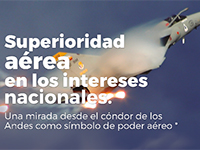Air Superiority and National Interests. A Perspective from the Andean Condor as a Symbol of Air Power
DOI:
https://doi.org/10.18667/cienciaypoderaereo.638Keywords:
Air Superiority, Air Supremacy, Air Power, Military Power, Doctrine, Security, Defense, National InterestAbstract
This article describes and analyzes the concept of Air Superiority beyond the doctrine of air power. First, we shall search within our national symbols, looking for the meaning of the Andean Condor in regards to Air Superiority. Then, we shall present what superiority could be as a comprehensive causal system of necessary effects on the enemy and as a response to the Security and Defense obligations of the Military Power. Finally, we shall lay out the importance that air superiority should have on our national interests for the survival of the nation. In regards to the above, we shall consider three critical elements for the attainment of the objectives of this document: the doctrine and vocation of service to the nation that an air institution has developed, the evolution of air power throughout history and its wars, and the necessity of political will to realize the vision of a free nation.
Downloads
References
Air University (2015, Octubre). First and Most Important: Air Superiority in the Joint Force. Obtenido de http://www.airuniversity.af.mil/News/AUTV/videoid/430186/.
Álvarez, C., Santafé, J. y Urbano, O. (2017). Metamorphosis Bellum: ¿Mutando a Guerras de Quinta Generación?. En Álvarez, C. (ed), Escenarios y Desafios de la Seguridad Mutidimensional en Colombia (pp. 145-248). Bogotá: Ediciones Esdegue.
Álvarez, C., Murillo, S., Hernandez, J. y Urbina, J. (2019). El Poder Espacial y la Seguridad Mutidimensional. En Álvarez, C. y Corredor, C. (eds), El Espacio Exterior: Una Oportunidad Infinita para Colombia (vol. 1, pp. 19-82). Bogotá: Ediciones Esdegue.
Álvarez, J. (2003). El Interés Nacional en Colombia. Bogotá: Universidad Externado de Colombia.
Cancillería. (2018, Marzo). Símbolos patrios y otros datos. Obtenido de Cancillería: http://www.cancilleria.gov.co/colombia/nuestro-pais/simbolos
Carver, M. (1992). La Guerra Convencional en la era nuclear. En P. Paret, Creadores de la Estrategia Moderna. Desde Maquiavelo a la Era Nuclear (p. 969). Madrid: Ministerio de Defensa. Centro de Publicaciones.
Douhet, G. (1936). La Guerra del Aire. Bogotá: Talleres Mundo al día.
Douhet, G. (1987). El Dominio del Aire. Madrid: Instituto de Historia y Cultura Aeronáutica.
Enger, S. (2013). Dual-Use Technology and De-fence-Civilian Spillovers: Evidence from the Norwegian Defence Industry. Obtenido de https://pdfs.semanticscholar.org/946e/98c2c6e33500ed27b3d8fc63fe478b91785d.pdf_ga=2.238005381.486484208.1572731331586530143.1572731331.
Escrigas, J. (2010). Análisis comparativo del concepto de Interés Nacional. En CESEDEN, Evolución del concepto de Interés Nacional (pp. 41-73). Madrid: Ministerio de Defensa.
Fuerza Aérea Colombiana (2016). Manual de Doctrina Básica Aérea y Espacial, cuarta edición. Bogotá: Jefatura de Educación Aeronáutica-Centro de Doctrina Aérea y Espacial.
García, R. (2014). Así fue como aviones Kfir C-10 de la FAC interceptaron los bombarderos rusos TU-160. Obtenido de http://www.webinfomil.com/2013/11/Kfir-TU-160-Russia-Colombia.html.
Hernández, J. (2011). Operaciones Secretas de la Segunda Guerra Mundial. Madrid: Ediciones Nowtilus, S.L.
Herrera, J. (2015). El Mundo Escindido. Historia de la Guerra Fría. ND: Punto de Vista Editores.
Herrero, R. (2010). El Concepto de Interés Nacional. En CESEDEN (ed.), Evolución del Concepto de Interés Nacional (p. 195). Madrid: Ministerio de defensa.
Hunerwadel, J. (2006). El Método de Operaciones Basadas en Efectos (EBO). Air & Space Power Journal, ND.
Kennett, L. (1991). The First Air War 1914-1918. New York: Simon & Schuster.
Liang, Q., y Xiangsui, W. (1999). Guerra Irrestricta. Beijing: PLA Literature and Arts Publishing House.
Lind, W. (2004). Understanding Forth Generation War. Military Review, 12-16.
Macisaac, D. (1992). Voces desde el azul del cielo: Los teóricos del Poder Aéreo. En P. Parret (ed.), Creadores de la Estrategia Moderna: desde Maquiavelo a la era nuclear (pp. 639-664). Madrid: Ministerio de Defensa, Secretaría General Técnica.
Meilinger, C. (1996). Diez propuestas en relación con el Poder Aéreo. Obtenido de http://www.au.af.mil/au/afri/aspj/apjinternational/apjs/1996/4trimes96/meilinger.html
Mets, D. (2017, Mayo 28). Matar a un Ave de Acecho: Alimento para su Lectura Profesional en la Superioridad Aérea y del Espacio. Obtenido de http://www.airpower.maxwell.af.mil/apjinternational/apj-s/2000/1trimes00/mets.htm
OEA. (2003). Conferencia Especial sobre Seguridad. Ciudad de México: OEA.
Pike, J. (2000, Abril 23). E-3 Sentry (AWACS). Obtenido de https://fas.org/man/dod-101/sys/ac/e-3.htm
Presidencia de Colombia (2018, Marzo 19). Así es Colombia. Obtenido de http://wsp.presidencia.gov.co/asiescolombia/simbolos.html
Revista Sucesos (s. f.). La Historia de la Aviación. Obtenido de http://www.librosmaravillosos.com/lahistoriadelaaviacion/pdf/La%20Historia%20de%20la%20Aviacion%20%20Revista%20Sucesos.pdf.
Sanz, G. (2010). Intereses que afectan a la Soberanía Nacional. En CESEDEN, Evolución del concepto de Interés Nacional (pp. 77-108). Madrid: Ministerio de Defensa.
Warden III, J. (1988). The Air Campaign, planning for combat. Washington: National Defense University Press.

Downloads
Published
Issue
Section
License
Assignment of Copyrights
Authors assign Ciencia y Poder Aéreo journal the exclusive rights (reproduction, distribution, public communication, and transformation) to exploit and commercialize their work, in whole or in part, in all the formats and modalities of present or future exploitation, in all languages, throughout the life of the work and throughout the world.
All contents published in Ciencia y Poder Aéreo journal are licensed under a Creative Commons Attribution 4.0 International License, whose complete information is available at http://creativecommons.org/licenses/by/4.0/
Under the terms of this license, users are free to download, print, extract, archive, distribute and publicly communicate the content of articles, provided that proper credit is granted to authors and Ciencia y Poder Aéreo, scientific journal of the Graduate School of the Colombian Air Force. Except when otherwise indicated, this site and its contents are licensed under a Creative Commons Attribution 4.0 International License.
For other uses not considered under this license it is required to contact the Director or the Editor of the journal at the e-mail address cienciaypoderaereo1@gmail.com.
The Graduate School of the Colombian Air Force and this publication are not responsible for the concepts expressed in the articles, including the metadata or the affiliation stated by authors. This is the full responsibility of the authors.





















